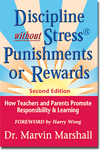|
 |
Subscribe for free home delivery |
|
To Promote Responsibility, Elicit Rather Than Impose People do not argue with their own decisions | |
| by Dr. Marvin Marshall www.MarvinMarshall.com Regular contributor to the Gazette February 1, 2008 |
|
|
In addition, when authority is used to impose, it deprives the student of an opportunity to become more responsible. Working WITH the student, rather than doing things TO the student, is so much more effective. This approach avoids the problems typically associated with imposing something because (a) students will not feel like victims when they design their own consequence (b) they are guided to focus on learning from the experience. By ELICITING, rather than IMPOSING a consequence, the young person owns it. People do not argue with their own decisions. By imposing a logical or natural consequence, the responsibility for thinking about the nature of the consequence falls to the adult, rather than upon the student. The student (as opposed to the teacher) should be the one required to do the most thinking. Here is an example to help understand the difference between something imposed and something elicited. A young student has scribbled on a wall or an older student has vandalized a wall with graffiti. In a school where consequences are imposed, the adult would think about the situation and arrive at a consequence that seems fair and meaningfully related to the misbehavior. In this situation, the adult would decide that, as an appropriate consequence the student should be required to clean up the mess on the wall. The adult would impose the consequence, thereby making it feel like punishment. However, in a school using a collaborative approach working WITH the student, the situation would be handled differently. The teacher would expect the student to do the thinking, thus allowing the student an opportunity to take responsibility. Instead of imposing a consequence on the student, the teacher would elicit an appropriate consequence from the student. The student would be asked, “What do you think should happen now that you’ve marked on the wall making the school less attractive to everyone else?” Because the student would be asked to think, you can imagine the student might say something like, “I should clean the wall.” The teacher would agree that this would be a suitable consequence. Interestingly, in either case, the consequence is exactly the same; the person who committed the act cleans the wall. You may ask, “What’s the big deal? If in both scenarios the situation ends up that the young person cleaning up the mess made on the wall, why does it matter who thought of the idea?” This one difference is critical. Learning, growth, and long-term change come as a result of reflecting about one’s actions and about the outcomes that may result from them. By being prompted to think about and determine the consequence, the student not only takes ownership and responsibility but also is more likely to make more responsible choices in the future. In summary, the most effective way to promote responsibility--be it regarding inappropriate behavior, reducing apathy toward learning, or even with home assignments--is to ELICIT a consequence, rather than impose one. | |
|


 His approach is the only system that is proactive, totally noncoercive, and does not use external manipulatives or threats. He INDUCES students to WANT to act responsibly and WANT to put forth effort to learn.
His approach is the only system that is proactive, totally noncoercive, and does not use external manipulatives or threats. He INDUCES students to WANT to act responsibly and WANT to put forth effort to learn.
